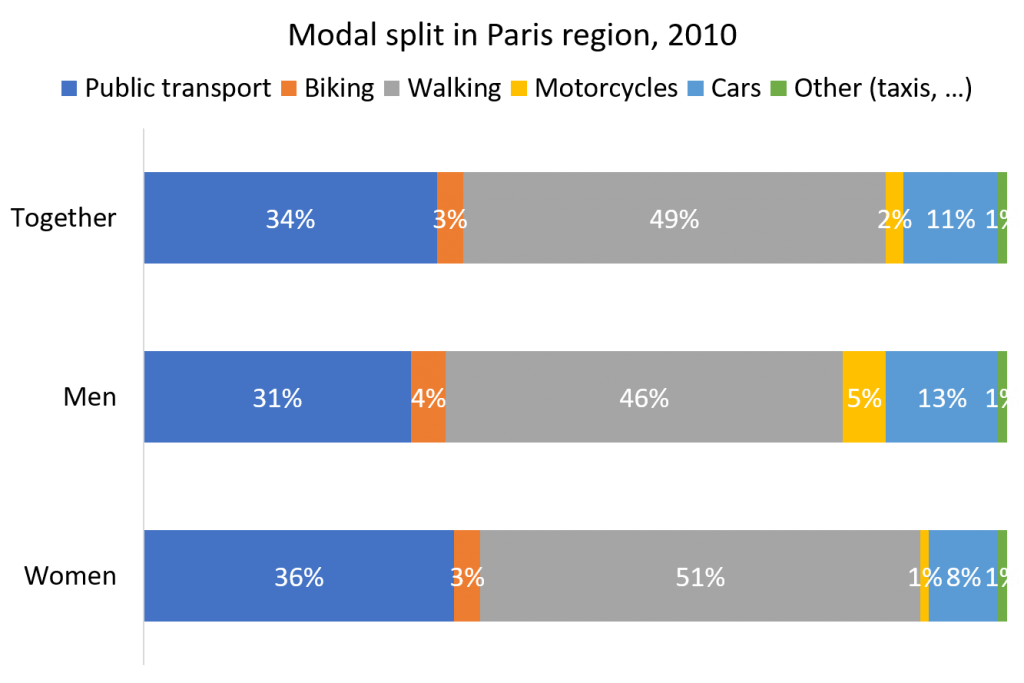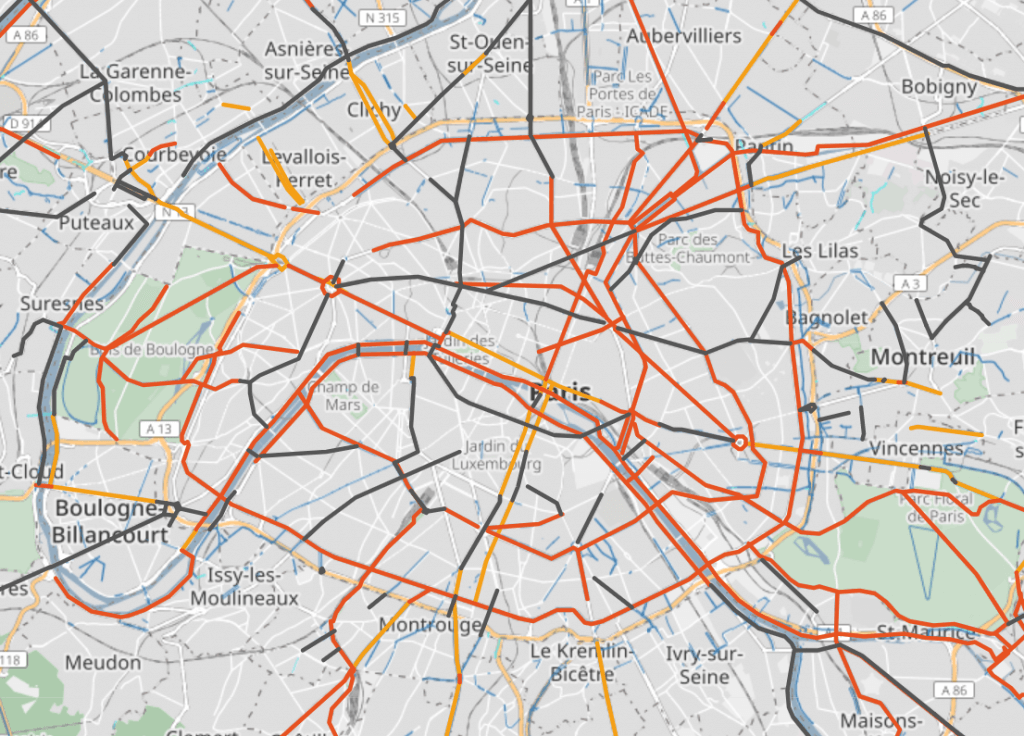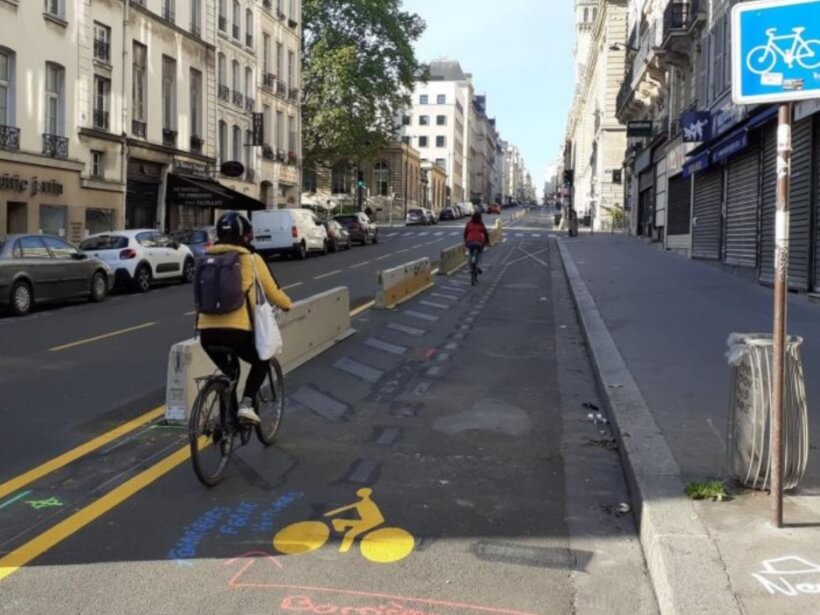The pandemic forces urbanites to change their relationship with public transport
By mid-April 2020, up to a third of the world’s population was subject to some sort of lockdown measures to contain the spread of the COVID-19 pandemic. For the sake of social distancing, to keep everybody safe from such a severe and unfamiliar disease, people had to restrict their movements to the strict essentials. Astonishing images of empty streets of normally vibrant urban centres of leisure, business and tourism that are now part of our collective imaginary have proliferated the news and social media.
In Paris, this sudden void in the public space was also noticeable in public transport: social distancing and mass transit are two concepts that do not sit well together. In Paris, for instance, as a response to stringent physical distancing measures, operations were reduced to 30% of capacity. Only 4% of pre-lockdown ridership remained. Public transport services were mostly maintained for essential workers.

The issue here is that public transport is the second most used mean of transport (34% of trips) after walking (49% of trips) in the French capital. Personal motorized vehicles (cars and motorcycles, 13%), cycling (3%) and taxis (1%) made up for the rest of the modal split in 2010[1]. As such, public transport operators RATP and SNCF serve more than 12 million trips on a daily basis and therefore play a major role in the metropolis’ economy and quality of life.
On May 11th, as the epidemic situation in France improved, some strict lockdown measures were lifted. However, social distancing remains the rule. Thus, the requirement for physical distancing combined with Parisian dependence on public transport, poses significant challenges for returning back to normalcy.
For the local public authorities, releasing crowds into the mass transit of one of the densest cities in Europe can only be a source of anxiety of being hit by a second wave of contagion in the near future. Well aware of this dilemma and personal risk, a large part of the millions who were previously relying on the public transport for their daily commutes will have to choose new solutions.
Women use the Paris public transport more than men and make several short trips
Parisian women found themselves to be particularly vulnerable in this situation compared to men, as women are statistically over-represented among public transport commuters. Biking mode shares between genders are also unequal. While bicycles historically helped women emancipate in the first half of the 20th century, men are statistically over-represented among daily cyclists. Female bicycle riders made up 40% of Vélib’ users[2] in 2014, a share that might be representative of the gender distribution of all bicycle users in Paris, although no recent accurate data seems to exist.
Not only is there differences in the use of different transport modes, but also in commuting patterns. While men are more likely to use personal vehicles (cars[3], motorcycles, bikes) and make fewer trips but on longer distances, women tend to walk and ride the public transport more in order to make several short trips. Women are also more likely to trip chain, that is, make stops along the way to other destinations.
These differences in travel patterns and mode choice originate in the historical differences of socio-economic roles and activities between men and women. Women also face different constraints than men in accessing, using and paying for transport services. Under the pressures of the long lasting patriarchal norms of the French society, women more often perform time consuming domestic chores such as caring for dependent family members (bringing/picking children up from schools or from extracurricular activities, visiting elderly parents), buying groceries, dealing with administrative requirements, etc. These tasks are often all performed while occupying a professional position, which is more likely to be a part-time job than for men. Men on the other hand, tend to allocate more time to their professional activities, which tend to be located further away from their homes, and to personal free-time entertainment.
A risk of gender inequalities aggravating due to the sanitary crisis
In the current context, these preexisting differences in activities and mobility patterns indicate that men are more likely to better adapt and overcome the requirements of social distancing as their pre-crisis habits were more fit to individual mobility solutions.
During the quarantine, reports of gender inequalities aggravating due to the sanitary and economic crisis have been spread by the national media. Confinement has also fostered interpersonal tensions bringing about an increase in domestic violence as many women found themselves with no escape from their abusers. In public spaces and transport, many expressed an increased feeling of vulnerability and insecurity as sexual harassment instances were reported to have escalated. Chris Blache, sociologist and co-founder of urban studies consultancy Genre et Ville, attempted to explain the current rise of street and transport sexual harassment by pointing out that emptier streets meant an absence of social pressure which may accentuate sexist behaviours of men who feel entitled to the ownership of these spaces as they feel entitled to the ownership of women’s bodies.
Women’s both economic and personal vulnerability to the crisis call for significant counter measures to guarantee women’s security and freedom of movement.
Cycling as a solution, but guaranteed safety as a condition
As women make up a majority of public transport users, and these networks now show a sanitary risk, new and safe solutions are needed to fulfil women’s daily commuting needs. Along with walking, cycling has become a viable solution that could help ensure safe distances between commuters. Cycling also has a variety of other obvious benefits, including health and low environmental footprint, and relative affordability for users.
However, binary gendered social constructs affect the practice of cycling too. Men are usually encouraged to confront themselves with risk, displaying their courage, strength and agility, which in turn grant them certifications of masculinity. At the opposite of these traits, femininity traditionally has been expressed with social requirements of vulnerability, sedentarism, and softness.
This results not only in lower education to cycling for young girls, but also a higher reluctance to take risks on the road. This entails that the perception of insecurity and a lack of safe cycling infrastructure is the main barrier to adoption of bicycles as a daily means of transport for many women[4]. Along with being exposed to catcalling while cycling, not feeling safe on the road simply makes women avoid using bikes in many urban contexts. Vélodacieuse[5], an awareness campaign led by association Femmes en Mouvement, recently showed the gaps of Paris’ cycling infrastructure in fulfilling women’s needs by taking city hall political candidates on cycling tours to show them what works and what does not.
If relieving pressure off individuals to adopt masculine or feminine traits depending on their genders can be a long-term wish to lower gender inequalities overall, adapting spatial infrastructure to accommodate for the needs of everyone is a pressing issue in order to have cities less designed by and for healthy men and more designed for everybody’s greater well-being.
Corona-pistes to address the main barrier following recent progress in new infrastructure
The ongoing implementation of temporary cycling paths, the so-called corona-pistes[6], by several cities in France and around the world including Paris, could potentially help filling the gender gap in cycling practices. In an attempt to discourage the use of public transport and maintain crucial social distancing, the municipality of Paris has been creating new paths on major transport axis with the aim of having a maximum number of inhabitants use bicycles over other means. Concretely, the new paths were drawn using yellow paint, while plastic cones were put in place in order to physically separate bike paths from car traffic. For the planning of these paths, the city authorities benefitted from the quasi-total absence of motorised vehicle traffic during the lockdown. Also, in some instances, streets were totally shut off to motorized vehicles until further notice (exempting buses and taxis) to allow people on bikes to entirely use them.
The correlation between quality of infrastructure[7] and high cycling practice (among the general population but also among women) has been demonstrated on several accounts. In the French context, the city of Strasbourg, in the East of the country, has been investing in safe quality cycling infrastructure for a few decades and now sees 10% of trips realised by bikes with women representing 47% of daily cyclists. In the south-east French city of Saint-Etienne, on the other hand, only 0.5% of trips are made by bike and only 15% of people on bikes are women as the city neglected cycling as a proper means of transport. Furthermore, in countries with extensive safe cycling networks and where children are encouraged to use them at an early age, such as the Netherlands or Denmark, the gender gap is very low and, in some places, women are even over-represented among bike users.
The corona-pistes policy is an example of the urban planning instrument called “tactical urbanism”. Although it is generally associated with bottom-up citizen initiatives, the term can also be adopted here as it refers to low-cost changes to the built environment intended to improve local neighbourhoods. Tactical urbanism goes temporarily around public procurement requirements and is about fixing long-lasting problems fast. With corona-pistes, the city of Paris made in a few days what was been planned to be done over several years. As many speculate on their “temporary” nature and believe that some paths are there to stay, this experience could be an important testing ground for more long-term changes to the urban environment.

Even before the crisis, Paris achieved significant results in promoting biking by adopting a proactive policy to reduce road space available for automobile traffic through the transformation of urban public space. Policies in this direction include developing and improving the cycling network, public financial support to buy e-bikes, the operation of the Vélib’ bikes, a flexible policy to the regulation of free-floating bikes fleets, or the promotion of cycling schools for adults. September 2019 marked a pivoting moment for cycling in Paris as a record number of new cyclists hit the road on newly finished paths, a trend that intensified during major public transport strikes of December and January. It is worth noting that the city is not the only public entity seeking a “more people on bikes” agenda, as regional authorities and the national government are also implementing bicycle policies.
However, while efforts are recognised, activists advocating for a fairer distribution of public space criticize the lack of a “cycling culture”[8] among urban planners and policy makers who are directed by 70 years of pro-car discourses and urban policy in a systemic way. Improvements are too often made retroactively as, even for newest urban refurbishment, solutions for bicycles are only thought of, and often badly so, after an initial delivery.
Results of corona-pistes: an increased number of people on bikes
Three weeks after the end of strict quarantine measures, allowing Parisians to leap outside their homes, reports show a record numbers of people using bicycles (see graph), exceeding pre-COVID-19 numbers that were already considered exceptional for the French capital, to the great delight of bicycle stores owners.

It is hard to quantify how much corona-pistes contribute to this significant increase in bike adoption as counters only measure flows on preexisting cycling paths. This boost must also be put within the context of a preexisting trend of the surge of bicycle usage, backed by favourable policies. However, comparing data from 1 year apart shows a major increase which doesn’t leave much doubt behind the effect of the sanitary crisis’ end on bicycle usage.
What is certain is that the new infrastructure and expanded cyclable area complement a network that was suffering from holes and allow for some people to navigate safely. They are also less exposed to the virus as they would have been using other means of transport. Fundamentally, corona-pistes alleviate the perception of urban cycling as being reserved to daredevils. For women especially, the sudden improvement of the cycling network contributes to lowering of the most significant barrier to adoption, bridging the gap and moving towards more equal access to public space.
[1] This modal split concerns trips made within Paris’ region and was measured in 2010 by the decennial orgin-destination survey of the île-de-France Mobility Observatory. It is the most accurate data on transport use to date for Paris region.
[2] Vélib’ is Paris’ public bicycle sharing service. Launched in 2007, it encompassed in 2019 close to 20 000 bikes distributed among 1 400 stations for 81 500 daily uses and 175 000 frequent subscribers.
[3] It was demonstrated that, if a heterosexual household owned car, the man is more likely to be its main user.
[4] Apart from distance, other barriers to the adoption of bicycles as daily means of transport include women’s social stigmas of being sweaty at the job site or wearing “non-feminine cloths”, the device itself not being adapted to women’s needs of transporting children or groceries, and affordability. There are, however, solutions to these barriers. Apart from equalising gender roles and changing image expectations, electric bikes allow for travelling great distances without sweating and electric cargobikes make it possible to carry several hundred of kilos of goods or children over long distances. Further cycling solutions exist for people with a disability.
[5] A name built around a play of word between vélo, bicycle, and audacieuse, feminine form of audacious/bold.
[6] Corona-piste is a portmanteau word of coronavirus disease and piste, French for path.
[7] What is commonly understood as high quality cycling infrastructure depends of the neighbourhood’s context but it generally aims at a maximum protection of cyclists from other road users. It can be materialised in, among other interventions, segregated paths, speed constraints for other users, or reserved streets. Particular attention should be given to junctions where collisions are more likely to take place. Designing Dutch junctions helps limitting risks.
[8] A generalised cycling culture would mean a systematic integration of cycling solutions in city planning works with high quality standards. A way to assess the quality of a cycling infrastructure that is recurrently suggested by observers is for one to ask herself: “would I let my 8 years old daughter cycle on this street alone?”.





